Roman Aquiline Sword Hilts
Jul 3, 2014 8:38:56 GMT
Post by Jack Loomes on Jul 3, 2014 8:38:56 GMT
Editor's note: Though measurements are not currently available for these two sword hilts, I believe they are sufficiently important to the archaeological record to warrant inclusion in this database.
If you possess verifiable measurements for these pieces please contact me.
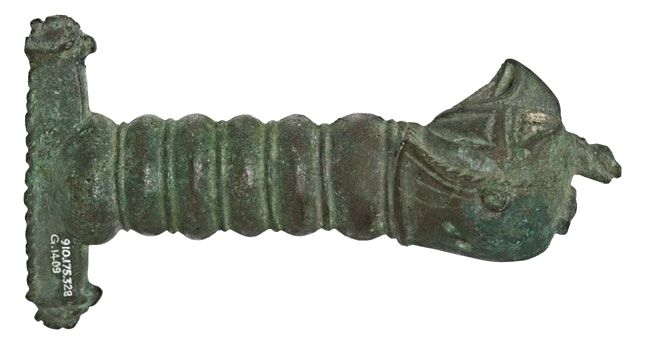
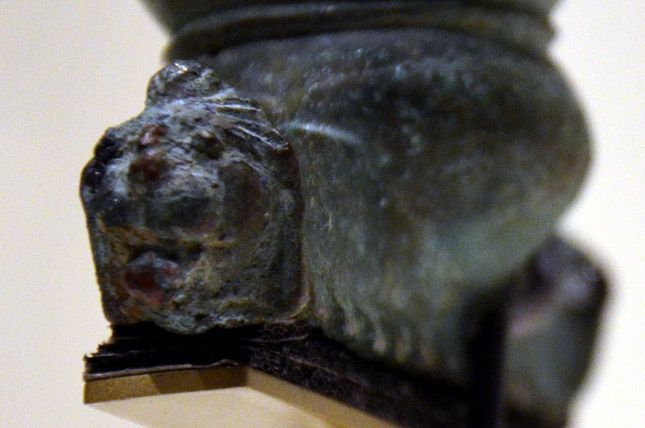
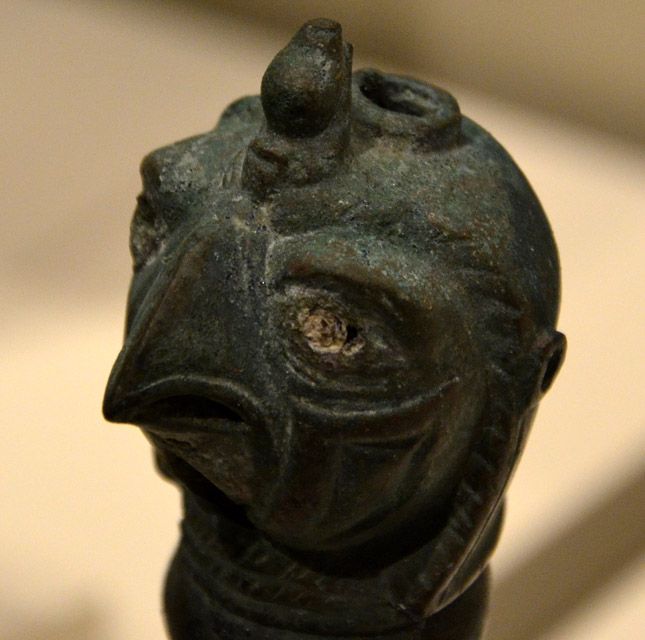
...weapon (910.175.328) is actually a part of a weapon, but a very important one, acquired before 1910 in Cairo by Charles Currelly and presently in the Eaton Gallery of Rome. It is the cast bronze hilt of a sword. It depicts a bird's head, which is actually the Horus falcon, as it has the crown of Upper and Lower Egypt on its head. Such influences from Ancient Egypt were common in Ptolomaic and Roman Egypt. The best known parallel we have to this sword grip are the hilts of swords depicted as being carried by the Emperor Diocletian and the Tetrarchy, dated to about 300 AD; but these and other known Roman swords are clearly eagles. The eagle was the primary symbol of the Roman army from the time of the reforms of Marius in 104 BC, but Horus is far more ancient, being an important god in Predynastic Egypt (before 3,200 BC). As the religion and pantheon of Ancient Egypt grew and synthesised with political unification, Horus remained important. Under the influence of the monotheistic Achaemenid Persians, who ruled Egypt between 525-402 BC and again in 343-332 BC, Egyptian religion seemed to become more centered around the Osiris-Isis-Horus trinity. This developed further under the Ptolomies (332-30 BC), with Osiris becoming known as Serapis and the child Horus known as Harpocrates. The Ptolomies typically had an image of Zeus in the form of an eagle standing on thunder-bolts on their coinage (see below), which may explain the continuity of the imagery of Horus as falcon. Under the Romans this trinity of the father Osiris/Serapis, the mother Isis, and their son the forgiving Horus/Harpocrates, became so popular that Augustus tried to restrict its growth. However, later Romans embraced these Egyptian deities, and under Domitian, emperor from 81 to 96 AD, temples were built to Isis and Serapis in Rome. In this time the symbolism of Horus as the embodiment of the pharoah, or the Emperor, the king that has come to judge, became very important. While Isis, Serapis and Harpocrates became Romanised in their appearance (see this beautiful vase in the ROM collection - note the little crown on Harpocrates' head), Horus in his personification of rule retained his traditional falcon-headed appearance. Statues of Horus in Roman armour exactly as deified emperors were depicted became popular (the British Museum has two, one standing, the other sitting , the latter one being the subject of an interesting study of its pigments - note the crown is missing but otherwise closely resembles the ROM's pommel). The symbolism of Horus as the vanquisher of Evil carried on perhaps into the Christian period, judging by a 4th century AD depiction in the Louvre that looks just like St. George and the Dragon.
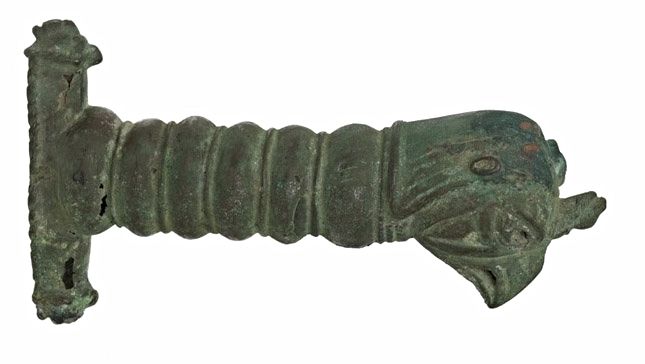
Source: www.rom.on.ca/en/blog/weapon-wednesday-a-romano-egyptian-sword-hilt
Editor's Note: This second example of an aquiline roman hilt is purportedly from a statue, and so may represent a style that was normally fashioned from timber, or perhaps, like the parazonium was cast from copper alloy. The third possibility is that this style of hilt had a timber grip and copper alloy pommel and cross guard like this sword: sword-site.com/thread/108/roman-tribunes-paraspatha-parazonium
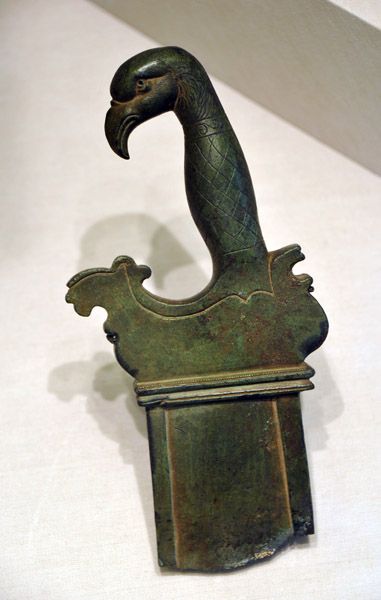
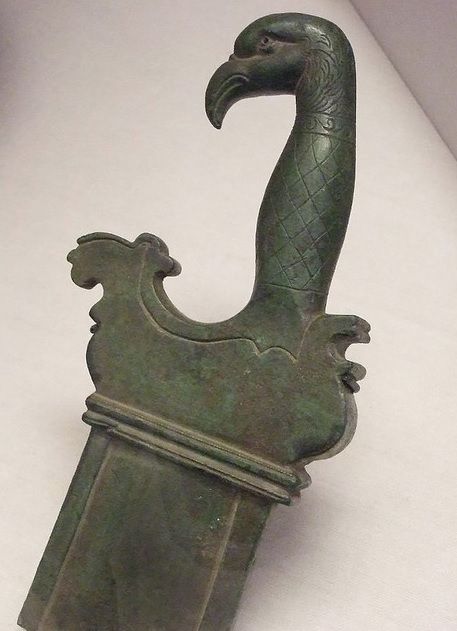
Another well known example of this type is depicted in the sculpture of the Tetrarchs of the Roman Empire, a porphyry (purple marble obtained only from a single location near Sudan) sculpture sacked from a Byzantine palace in 1204, now standing at the southwest corner of St Mark's Basilica, Venice. The sculpture may have originally been from Nicomedia, Sirmium, Mediolanum or Augusta Treverorum.
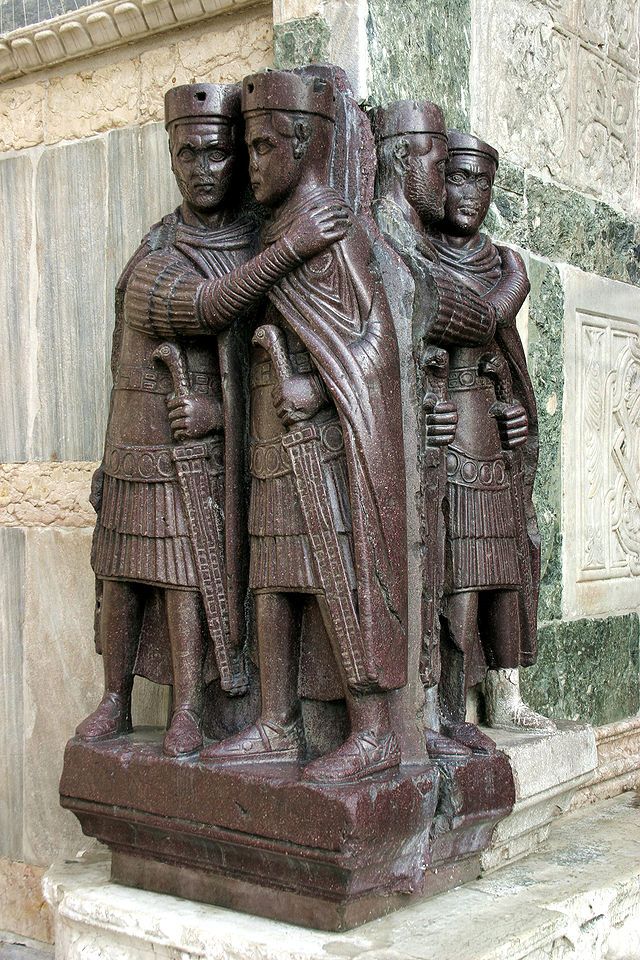
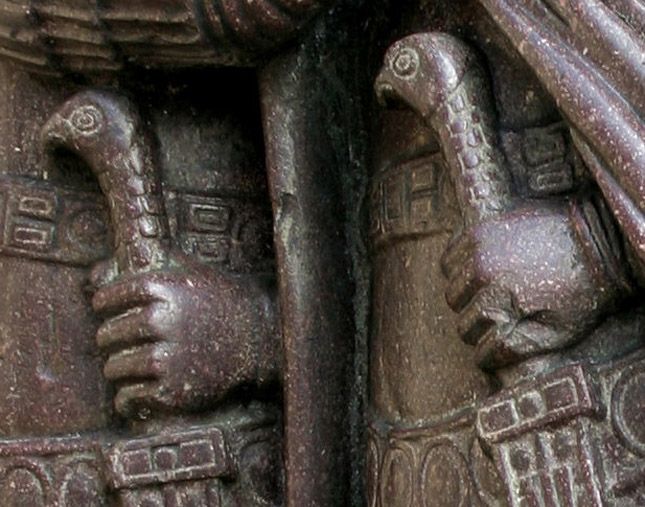
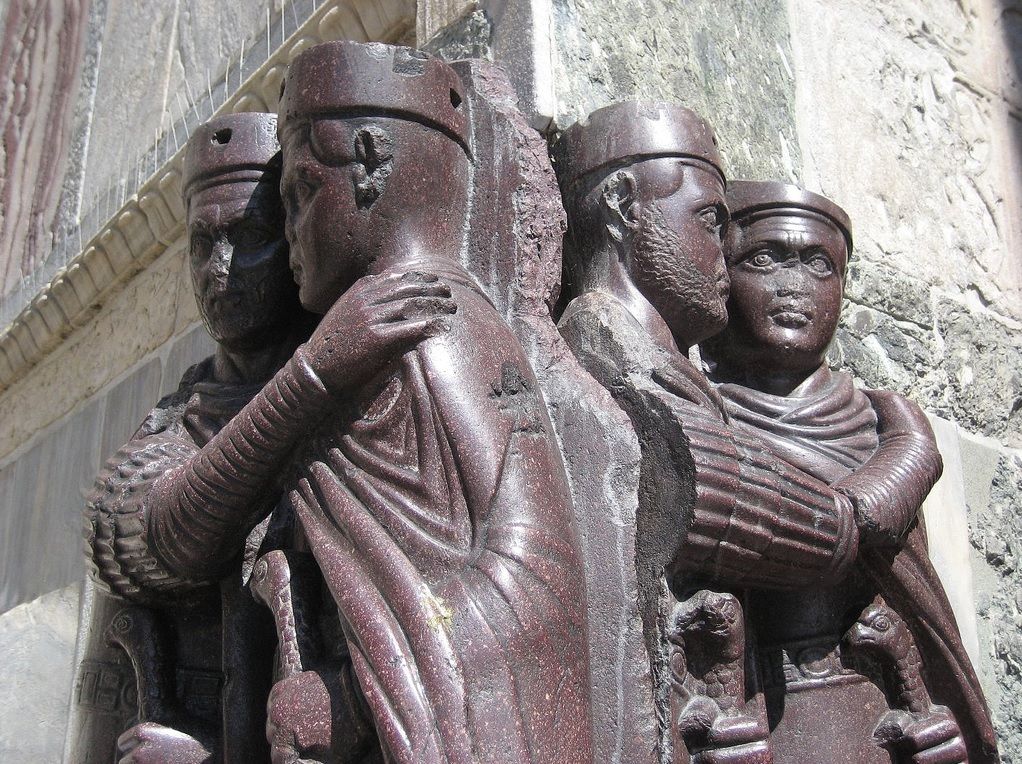
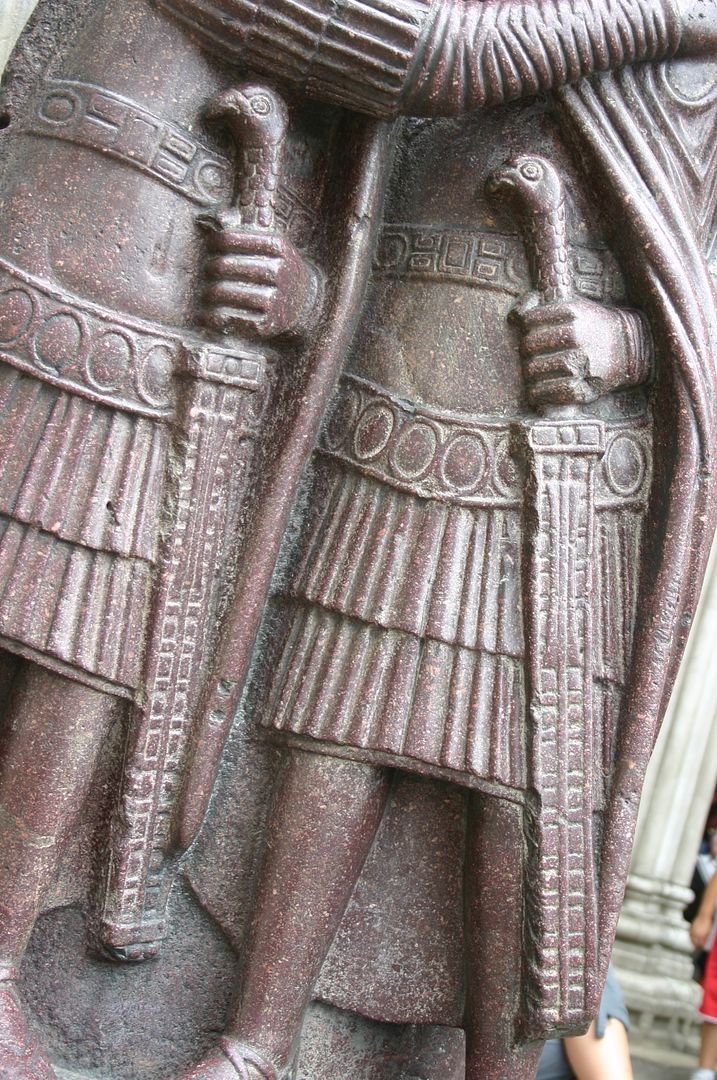
The swords clasped by the Tetrarchs are probably Roman adaptations of long, slender type of sword identified by A. Bruhn Hoffmeyer as type 28 (or a similar sword) - see: sword-site.com/thread/99/byzantine-swords?page=1
Source: www.pbase.com/bmcmorrow/image/131946982
If you possess verifiable measurements for these pieces please contact me.



...weapon (910.175.328) is actually a part of a weapon, but a very important one, acquired before 1910 in Cairo by Charles Currelly and presently in the Eaton Gallery of Rome. It is the cast bronze hilt of a sword. It depicts a bird's head, which is actually the Horus falcon, as it has the crown of Upper and Lower Egypt on its head. Such influences from Ancient Egypt were common in Ptolomaic and Roman Egypt. The best known parallel we have to this sword grip are the hilts of swords depicted as being carried by the Emperor Diocletian and the Tetrarchy, dated to about 300 AD; but these and other known Roman swords are clearly eagles. The eagle was the primary symbol of the Roman army from the time of the reforms of Marius in 104 BC, but Horus is far more ancient, being an important god in Predynastic Egypt (before 3,200 BC). As the religion and pantheon of Ancient Egypt grew and synthesised with political unification, Horus remained important. Under the influence of the monotheistic Achaemenid Persians, who ruled Egypt between 525-402 BC and again in 343-332 BC, Egyptian religion seemed to become more centered around the Osiris-Isis-Horus trinity. This developed further under the Ptolomies (332-30 BC), with Osiris becoming known as Serapis and the child Horus known as Harpocrates. The Ptolomies typically had an image of Zeus in the form of an eagle standing on thunder-bolts on their coinage (see below), which may explain the continuity of the imagery of Horus as falcon. Under the Romans this trinity of the father Osiris/Serapis, the mother Isis, and their son the forgiving Horus/Harpocrates, became so popular that Augustus tried to restrict its growth. However, later Romans embraced these Egyptian deities, and under Domitian, emperor from 81 to 96 AD, temples were built to Isis and Serapis in Rome. In this time the symbolism of Horus as the embodiment of the pharoah, or the Emperor, the king that has come to judge, became very important. While Isis, Serapis and Harpocrates became Romanised in their appearance (see this beautiful vase in the ROM collection - note the little crown on Harpocrates' head), Horus in his personification of rule retained his traditional falcon-headed appearance. Statues of Horus in Roman armour exactly as deified emperors were depicted became popular (the British Museum has two, one standing, the other sitting , the latter one being the subject of an interesting study of its pigments - note the crown is missing but otherwise closely resembles the ROM's pommel). The symbolism of Horus as the vanquisher of Evil carried on perhaps into the Christian period, judging by a 4th century AD depiction in the Louvre that looks just like St. George and the Dragon.

Source: www.rom.on.ca/en/blog/weapon-wednesday-a-romano-egyptian-sword-hilt
Editor's Note: This second example of an aquiline roman hilt is purportedly from a statue, and so may represent a style that was normally fashioned from timber, or perhaps, like the parazonium was cast from copper alloy. The third possibility is that this style of hilt had a timber grip and copper alloy pommel and cross guard like this sword: sword-site.com/thread/108/roman-tribunes-paraspatha-parazonium


Another well known example of this type is depicted in the sculpture of the Tetrarchs of the Roman Empire, a porphyry (purple marble obtained only from a single location near Sudan) sculpture sacked from a Byzantine palace in 1204, now standing at the southwest corner of St Mark's Basilica, Venice. The sculpture may have originally been from Nicomedia, Sirmium, Mediolanum or Augusta Treverorum.




The swords clasped by the Tetrarchs are probably Roman adaptations of long, slender type of sword identified by A. Bruhn Hoffmeyer as type 28 (or a similar sword) - see: sword-site.com/thread/99/byzantine-swords?page=1
Source: www.pbase.com/bmcmorrow/image/131946982

.png?width=1920&height=1080&fit=bounds)